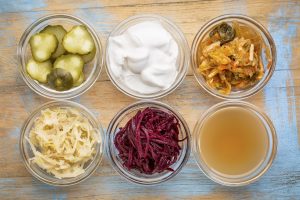 On a cold winter’s day there is nothing better than a hot cup of tea to warm you up. Depending upon the type of tea you consume, this warm beverage could provide you with a variety of different antioxidants to help benefit your health. In fact, a recent study has shown that a cup of hot tea every day may help reduce glaucoma risk.
On a cold winter’s day there is nothing better than a hot cup of tea to warm you up. Depending upon the type of tea you consume, this warm beverage could provide you with a variety of different antioxidants to help benefit your health. In fact, a recent study has shown that a cup of hot tea every day may help reduce glaucoma risk.
What is Glaucoma?
Glaucoma is the name for a variety of different eye conditions that involve damage to the optic nerve. Usually caused by an extreme amount of pressure in the eye, glaucoma is the leading cause of blindness in the United States. The most common form of this condition may not present any symptoms until it is too late. Therefore, it is very important to get regular eye check-ups to reduce your risk of eye health issues.
About Tea
Tea is a low-calorie beverage that can have anti-inflammatory and antioxidant properties. These benefits stem from the presence of the polyphenols epicatechin and catechin in tea. In particular, drinking green tea was shown to help lower LDL cholesterol, higher HDL cholesterol, and lower triglyceride levels.
Tea and Glaucoma Risk
A recent study looked at the results of a eye exam and nutrition survey of 1700 participants. Those people that drank tea every day had about a 75-percent less chance of having glaucoma than those who did not. It is not certain what about tea drinkers makes them at lower risk. However, this lower risk was only seen in those that drank hot, caffeinated tea. Consuming decaf tea, cold tea, or either decaf or caffeinated coffee did not show any benefit. It is thought that lower glaucoma risk may be due to the lifestyle factors in those that drank hot tea six times or more per week. More studies will need to be done to identify the direct link.
Other Ways to Lower Glaucoma Risk
Besides drinking hot tea, there are several other ways to lower your glaucoma risk. The researchers suggest that prevention through regular eye exams is key, along with the following lifestyle behaviors.
- Get your heart health under control. By getting your blood pressure and diabetes under control, you can help decrease your risk of glaucoma.
- Use treatments as prescribed. Prescribed eye drops or other glaucoma medications can help reduce the risk of complications associated with the condition. In turn, treating such symptoms can prevent or delay the onset of vision problems associated with this condition.
- Exercise regularly. Walking or engaging in some sort of moderate exercise each day could help reduce the eye pressure related to glaucoma. Moderate exercise may include swimming, biking, aerobics, dancing, or anything that quickens your breathing without getting you out of breath.
- Wear eye protection. Be sure to wear sunglasses or goggles in the sunlight or when using any power tools or engaging in any high-speed racket sports. This is because when you reduce your risk of eye injuries, you also help reduce glaucoma risk.
- Take eye-healthy supplements. Ocutain by Vita Sciences contains a combination of eye-healthy compounds such as lutein and beta carotene, which promote healthy vision. Such supplements, along with a heart healthy diet may help lower your risk of eye conditions such as glaucoma.
-written by Staci Gulbin, MS, MEd, RD, LDN
Sources:
Cochran, N. (January 12, 2017) “The Health Benefits of Tea”
Harvard Health Publishing: Harvard Medical School (August 2014) “Tea: A Cup of Good Health?”
Mayo Clinic (September 15, 2015) “Glaucoma”
Mayo Clinic (May 19, 2017) “Exercise intensity: How to measure it”
Medline Plus (December 15, 2017) “Could a Hot Cup of Tea Preserve Your Vision?”


 If you have ever tried to lose weight, then you probably have been told to track your calories. Most calorie trackers focus on keeping track of the calories you consume through food. On the other hand, fitness trackers or workout machines may track how many calories you burn during the day. However, is there more to the story of weight loss, or is calories in and calories out the only key to success? A recent report by health experts reveal that there may be more than simple math in the weight loss equation.
If you have ever tried to lose weight, then you probably have been told to track your calories. Most calorie trackers focus on keeping track of the calories you consume through food. On the other hand, fitness trackers or workout machines may track how many calories you burn during the day. However, is there more to the story of weight loss, or is calories in and calories out the only key to success? A recent report by health experts reveal that there may be more than simple math in the weight loss equation. Do you think you eat enough fruits and vegetables every day? You may track your macronutrients, have an apple a day, and be free of digestive concerns but still be missing the mark. A recent report by the Centers for Disease Control (CDC) has found that most adults in the United States could stand to eat a lot more fruits and vegetables each day.
Do you think you eat enough fruits and vegetables every day? You may track your macronutrients, have an apple a day, and be free of digestive concerns but still be missing the mark. A recent report by the Centers for Disease Control (CDC) has found that most adults in the United States could stand to eat a lot more fruits and vegetables each day. Are you looking for a more natural way to deal with your rheumatoid arthritis pain? Some prescription medicines may make you feel foggy, cause stomach ulcers, or cause weight gain. However, recent studies have shown that more natural antioxidants may help reduce rheumatoid arthritis pain without so many side effects.
Are you looking for a more natural way to deal with your rheumatoid arthritis pain? Some prescription medicines may make you feel foggy, cause stomach ulcers, or cause weight gain. However, recent studies have shown that more natural antioxidants may help reduce rheumatoid arthritis pain without so many side effects. A journal article in the Frontiers in Nutrition suggested that fiber-rich and antioxidant-rich foods may decrease inflammation in those with RA. Furthermore, it was suggested to get such benefits from some of the following foods and drinks.
A journal article in the Frontiers in Nutrition suggested that fiber-rich and antioxidant-rich foods may decrease inflammation in those with RA. Furthermore, it was suggested to get such benefits from some of the following foods and drinks.
 If you have ever had a migraine headache, you know the pain is so intense that a trip to the hospital may be in store. In this case, the ER staff may use an opioid pain medicine as a first resort. However, a recent study has shown that this commonly used drug, also known for its addictive qualities, may not be the best choice for migraine relief.
If you have ever had a migraine headache, you know the pain is so intense that a trip to the hospital may be in store. In this case, the ER staff may use an opioid pain medicine as a first resort. However, a recent study has shown that this commonly used drug, also known for its addictive qualities, may not be the best choice for migraine relief. According to the National Institutes of Health, the average American can live an average of 79 years. However, did you know that a few small lifestyle changes could add years to your life? It was found that for every few pounds you lose you could be adding years to your life.
According to the National Institutes of Health, the average American can live an average of 79 years. However, did you know that a few small lifestyle changes could add years to your life? It was found that for every few pounds you lose you could be adding years to your life. you have high blood pressure, heart disease may be the health concern most on your mind. However, high blood pressure can be a risk factor for more than just heart conditions. A recent study has found that women in their 40’s with high blood pressure have an increased risk of dementia.
you have high blood pressure, heart disease may be the health concern most on your mind. However, high blood pressure can be a risk factor for more than just heart conditions. A recent study has found that women in their 40’s with high blood pressure have an increased risk of dementia.